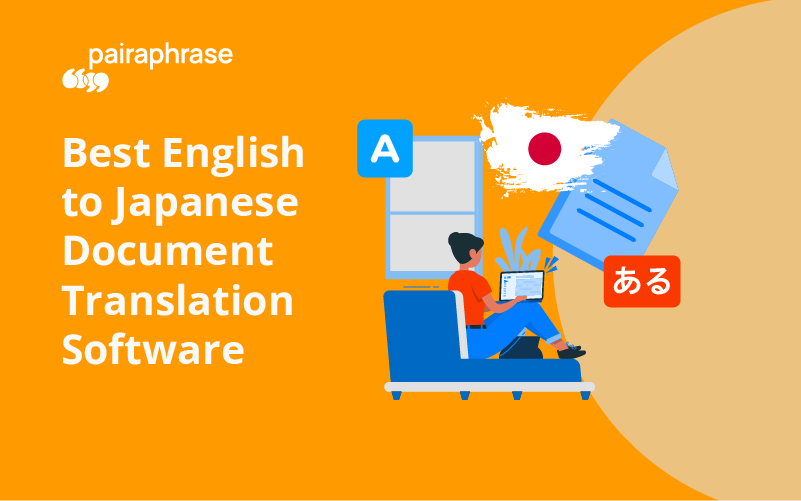Want the best English to Japanese document translation software?
You have a variety of options when it comes to language translation applications that allow you to translate from English to Japanese (and Japanese to English). Some are free, and some are premium solutions. Some translate scanned documents, others don’t.
But when you assess all your options, you want to make sure your first choice in English-Japanese translation software gives you access to the best suite of translator tools available.
This is why we’ve compiled this list of the best features to look for in English to Japanese document translation software. Along with a recommendation for a translation tool that comes with all of them.
Need to translate ASAP? Check out the AI Japanese file translator Pairaphrase.
12 English to Japanese Document Translation Software Must-Haves
Here are the top 12 features English to Japanese translators absolutely cannot do without:
1. Japanese-English Language Pair
If access to English to Japanese translation software is important for your business, then you also want to make sure you choose an app that will translate Japanese to English.
Business communication is never a one-way street. Therefore, do a favor for your colleagues (or customers) in Japan and make sure your English-Japanese document translation tool will also translate the other way.
2. Machine Translation to Produce an English to Japanese First Draft
English to Japanese machine translation is as good as it’s ever been. It can save you a lot of time and translation-related costs. That being said, it’s best to choose document translation software that includes machine translation to produce a first draft translation.
3. Translate English Files into Japanese Files
When searching for the best English to Japanese document translation software, a powerful file translator is a must-have feature.
Ideally, the software will run your English file through machine translation and give you a first-draft Japanese translation that you can then edit for quality improvements. This interface will display your file text in segments, placing the source segment and target segment side by side for easy editing and creation of translation memories (see #5 for more information).
4. Gist English Text into Japanese Text
If you communicate informally online with Japanese speakers (think instant messages or email), you’ll want a tool that helps you to get the basic idea of a chunk of text quickly. Sometimes you’ll have translation needs that don't involve documents, so the ability to copy & paste text into a gisting tool is a necessity.
5. Artificial Intelligence
Translating large volumes of text from English to Japanese? You’ll need English to Japanese document translation software that uses artificial intelligence.
Look for Dynamic Machine Learning and Translation Memory when shopping for a translation solution. These two technologies work hand-in-hand to deliver continuous quality improvements for your Japanese translations while reducing hours worked.
You might even consider translation software with AWS (Amazon) as an engine. This will get you as close to human quality translation as possible, as long as you’re willing to invest some upfront work to develop a term base glossary.
Learn more in the video below.
6. Translate Batches of English Documents into Japanese
The productivity power of Dynamic Machine Learning is amplified when you use batch file translation. Batch file translation allows you to simultaneously run groups of files through machine translation to perform quick English-Japanese document translation.
7. Interactive English-Japanese Glossary Integration
Most translation errors occur due to incorrect terminology. Therefore, it’s important to choose translation software that offers terminology management. This way, you can import a glossary to avoid errors and dramatically improve your translation quality.
You’ll notice a reduction in time spent on post-editing.
8. Automatic File Formatting
Many translation software users find their translated documents don’t retain publishable quality. That’s why you should look for automatic file formatting in an English-Japanese translator tool.
This technology encodes your original file so that when you download the translated version from your software, it will preserve as much of the original layout, font, spacing, styles and image placement as possible. It’s not perfect, but it will help you save hours spent reformatting the file.
9. Translation Management
A strong translation management component will help you manage your English to Japanese document translations and effectively collaborate with team members in a central hub to streamline the post-editing process. So seek this out in document translation software.
Avoid translation management systems (TMS) with confusing toolbars or that require a huge learning curve.
10. OpenAI Integration for Efficient English to Japanese Translation
An OpenAI integration can greatly enhance English-to-Japanese translation by addressing key challenges. By using ChatGPT within your translation software, you can easily restructure sentences to match Japanese grammar, transforming the SVO order of English into the SOV order of Japanese.
This direct access improves security and post-editing efficiency by eliminating the need to leave the software. Additionally, OpenAI's ability to handle multiple Japanese scripts—kanji, hiragana, and katakana—ensures visually correct translations, aids in selecting proper kanji characters, reduces ambiguity, and improves readability.
11. Google Drive Integration
A Google Drive integration is particularly useful for teams who work with Google files.
Your team will save time with seamless file access which eliminates time lost to manual downloads and uploads. With this integration, you can translate Google Docs, Google Sheets, or Google Slides directly into Japanese without moving them in and out of your Google Drive.
12. Enterprise Security
Finally, you’ll want to invest in English to Japanese document translation software that has strong security. Learn more about the importance of security in the video below, and the specific security measures you should look for.
Recommended English to Japanese Translator Tool
Wondering how to find the best English to Japanese translation application with all these capabilities? Try Pairaphrase. It’s the AI-powered translation management system for teams who value smarter, faster and safer translation.
Pairaphrase supports 140+ languages and 20,000+ language pairs, including Japanese. Not to mention, it performs file translation for 24 file types.



.png)

.png)




